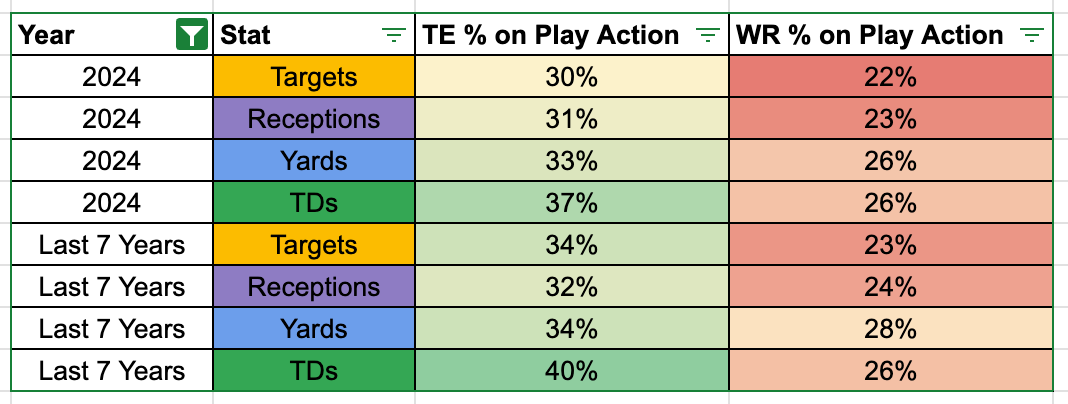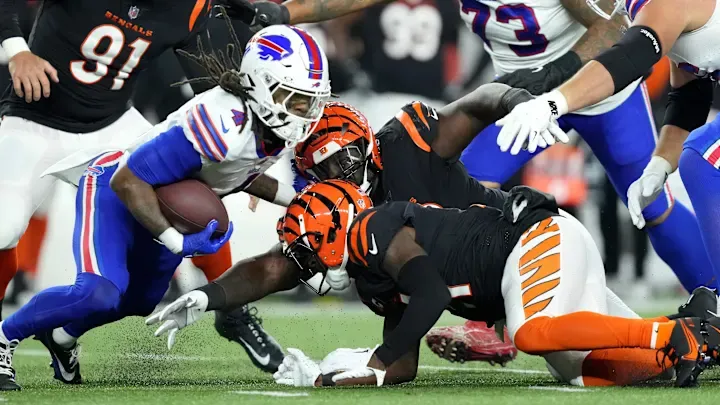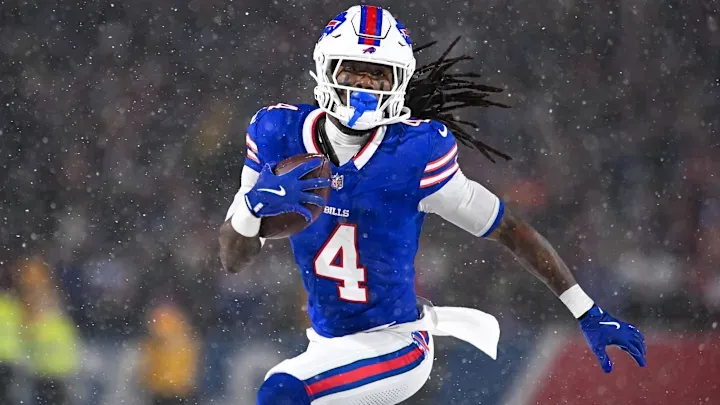
Which Tight Ends Got That PAPR?
A couple of summers ago, I wrote about tight end dart throws, and as part of that research, created a new stat called Play Action Participation Ratio, or PAPR.
PAPR is simply a TE's route participation on play action dropbacks divided by their overall route participation. The resulting stat helps us quickly identify which TEs are a key part of the play action game, and often just as importantly, which aren't.
And we really want to know which TEs are on the field for play action.
To a much greater degree than WRs, TEs benefit from play action because the position generates a much larger percentage of its fantasy production on play action dropbacks.
For example, in 2022, TEs saw 33% of their targets on play action. WRs were at just 24%. Here's the chart from the original article:

This effect has persisted, with play action continuing to be a driver for TE production overall, but especially for TD production... which we obviously care a lot about.

This effect makes intuitive sense, given that the TE position is much more involved in the run game... and as it turns out, the fake run game.
"When a TE sells a run fake by engaging with a 250-pound run stuffer and then breaks into a route... he is doing something that very few WRs could physically achieve. And there's a decent chance that play is designed to take advantage of the run action by having the QB look to the TE as his first read.
To be clear, I'm not saying there's more fantasy value in a play action target than a non-play action target. There isn't. Targets are targets, and goal-line targets are goal-line targets. They're worth the same regardless of what created them. But for TEs, play action targets at the goal line may be stickier—because those targets play to the relative strengths of the position."
Play action is why we want tight ends to be sufficient run blockers. We don't need them to be road-grading extra offensive linemen. But it's really helpful if they're trusted enough in the run game to be on the field for play action opportunities.
With that in mind, let's take a look at this year's tight end player pool, identifying starting TEs who are doing what we'd hope, starters with play action red flags, and players who could offer underpriced upside.
PAPR Delivery: Starters with Strong Play Action Involvement
(Players are in order of Underdog ADP. 2024 stats are Weeks 1-17.)
Brock Bowers
Brock Bowers' 0.85 PAPR ranked 13th among 33 qualifying tight ends (50%+ route participation, 200+ routes) last season.
Bowers is sometimes billed as a WR with TE eligibility, but that's not quite right. He's a true tight end... who also has the receiving skills of a wide receiver. He's not a tweener, he's a unicorn.
Even with Michael Mayer also on the roster, Bowers quickly established himself in the run game last year. Heading into his second season, he's set to be a focal point of the passing game, regardless of the formation or playcall.
Mat Irby recently identified Bowers as a positive TD regression candidate, and his play action involvement further cements his secondary breakout potential.
Bowers is an absolute smash in the mid-2nd round.
Trey McBride
Trey McBride has had very strong PAPR in each of the last two seasons. Last season, his mark of 0.91 ranked sixth among qualifying TEs. He's a PPR machine... but that's not because he's a fantasy scam; it's because he's a real life star.
McBride's lack of TD scoring has been well-documented, but even before we consider his PAPR, he's a positive regression candidate. Add in that he's a fixture of the play action passing game, and it's clear we have a player who offers both target share safety and underappreciated upside.
McBride is a priority target at the 2/3 turn.
George Kittle
Kittle's 0.81 PAPR is slightly lower than in 2022 (0.84) or 2023 (0.89). But it's still a solid mark.
As one of the best run blockers in the league, his play action role should remain strong in 2025. With Deebo Samuel in Washington and with Brandon Aiyuk recovering from a multi-ligament knee tear, Kittle's overall role in the offense looks locked in as well.
Perpetually underdrafted, Kittle is one of the best picks on the board.
Sam LaPorta
Sam LaPorta had a concerning 0.69 PAPR as a rookie, but was up to 0.78 last year, 17th among qualifying TEs. Considering that run blocking was a red flag in his prospect profile, his play action involvement has been nice to see, especially given how reliant the Lions have been on play action passing.
With Amon-Ra St. Brown locked in as Detroit's top target and Jameson Williams looking poised to take another step, LaPorta's path to target dominance looks very thin. But his play action involvement looks bullish, at least.
Under Ben Johnson, the Lions ran play action on a league-leading 37% of their passes. If John Morton calls plays at all similarly, LaPorta has clear TD-driven spike week upside, even if he's likely to operate as the No. 3 target in the overall passing game.
We have LaPorta right at ADP in the Underdog best ball rankings, but are significantly behind on DraftKings. Even on Underdog, I don't tend to take him that much in my actual drafts; he falls in a spot where I'm usually prioritizing WR or RB. And with LaPorta as the third option on his own team, it's hard for me to justify him if it means getting uncomfortable at either position.
Travis Kelce
Travis Kelce fell off in a number of ways in recent seasons, but he remained an important feature of Kansas City's play action attack. Kelce's PAPR of 0.88 ranked 10th among qualifying TEs last year.
Kelce is an extremely tricky player to price for 2025, as a further decline feels inevitable. But if he stabilizes in the role that he had last year, he's pretty clearly underpriced.
I'm willing to mix him in at his current ADP.
David Njoku
David Njoku has been consistently involved on play action over the last three years and is coming off an impressive 0.97 PAPR, the fourth highest among qualifying TEs. In fantasy, he might be a PPR scam, but in reality, he's a legitimate inline TE.
The Browns' Round 3 selection of Harold Fannin is a red flag for Njoku's overall route participation, perhaps, but as a TE in the big slot mold, Fannin is unlikely to displace Njoku in play action sets. The rookie creates some downside risk, but at least for 2025, he is probably a bigger threat to Diontae Johnson, Jamari Thrash, or whoever ends up winning the Browns' WR3 job.
Given the Browns' outrageously unsettled QB depth chart, Njoku isn't a very fun click. But he's a solid pick at ADP.
Tucker Kraft
Tucker Kraft's 0.92 PAPR ranked fifth among qualifying TEs last year and eases concerns that Luke Musgrave will challenge for a bigger role this year.
However, Musgrave had an even stronger 1.14 PAPR; he logged just 31% route participation, but saw 35% route participation on play action dropbacks.
The way I read this is that if Musgrave were to take on a bigger role, that role would likely eat into some of Kraft's most valuable snaps. Not what we want.
So, it's worth keeping our ears to the ground for rumblings of a Musgrave hype train. But the more important data point is Kraft's strong overall involvement. If he can maintain the 2024 status quo, Kraft should be solidly productive for his cost.
Dalton Kincaid
Dalton Kincaid shares TE duties with Dawson Knox, who has a very strong play action role. Knox saw just 56% route participation last year, but logged 64% route participation on play action dropbacks, for a 1.14 PAPR, the highest among qualifying TEs.
However, Kincaid posted a respectable 0.82 PAPR, after a strong 0.88 mark as a rookie.
These numbers serve as a reminder that Knox and Kincaid often play at the same time. As a result, Kincaid isn't as negatively impacted by Knox's trustworthy blocking as the typical TE would be.
Kincaid's PAPR also undercuts the idea that he's a big WR who can't really play traditional TE. Sure, he's generally out there to catch passes, and he's not Buffalo's most trusted blocking TE. But, they trust him enough to involve him in the fake run game, which is ultimately all we care about. If he can get his overall route participation up from last year's uninspiring 64%, there's significant upside.
After dealing with injuries last year, Kincaid has looked healthy in the early offseason program and is someone I'm warming up to as a post-hype breakout candidate at his dramatically reduced price.
Dallas Goedert
Dallas Goedert is entering the final year of his contract and turns 31 in January. The Eagles, being a sharp organization, clearly have some reservations about inking Goedert to a new deal and shopped him around this offseason. At that time, it made sense for best ball drafters to bake some risk into Goedert's ADP. His 2025 outlook looked genuinely uncertain.
However, Goedert remains on the Eagles and profiles as their clear-cut starter, for one more season, anyway.
Goedert's 0.98 PAPR ranked third among qualifying TEs last year, which is really nice to see considering how run heavy the Eagles are likely to be. We want him on the field for those runs, so that he can be part of play action trickery.
With Goedert set to run back a well-rounded starting role, his current ADP doesn't make much sense. Goedert is a clear target.
Jake Ferguson
Jake Ferguson was the cover boy of my original article on PAPR, having flashed a league-leading 1.89 PAPR while backing up Dalton Schultz in 2022.
As a starter, he has posted impressive numbers, with a 0.92 PAPR in 2023 and a 0.99 mark that ranked second among qualifying TEs last year.
There's one thing worth noting, though... Brevyn Spann-Ford has generated some positive quotes this offseason and had a very impressive 1.51 PAPR last year. The good news is that Spann-Ford had just 0.73 YPRR compared to Ferguson's 1.27.
If Spann-Ford takes a step forward, it would likely impact Ferguson's overall role, including his play action snaps. However, this is probably more of a 2026 problem for Ferguson, who is entering the final year of his deal. This year, we can expect Ferguson to operate in a well-rounded role, making him a solid pick at his cost.
Hunter Henry
When writing up Henry in 2023, I noted that his play action participation was concerningly low. Fortunately, things have improved since Jonnu Smith's departure.
Henry posted a 0.81 PAPR in 2023 and was up to 0.89 last year, ninth among qualifying TEs. Austin Hooper (1.15) will steal some looks out of 12 personnel and will occasionally supplant Henry in play action looks. But Henry led 80% to 43% in overall route participation last year, operating as the clear-cut starter. Barring rumblings of a Hooper-naissance, Henry appears set up for a strong role this season. He's a target.


